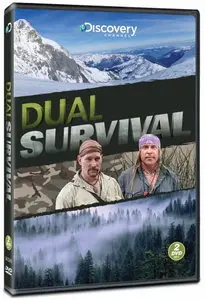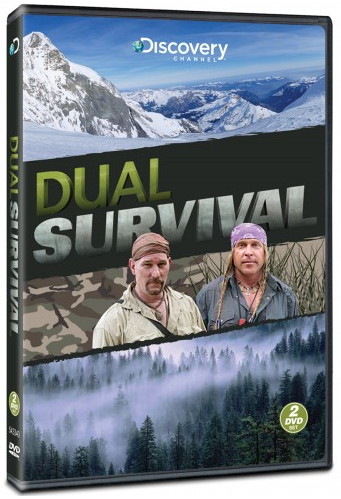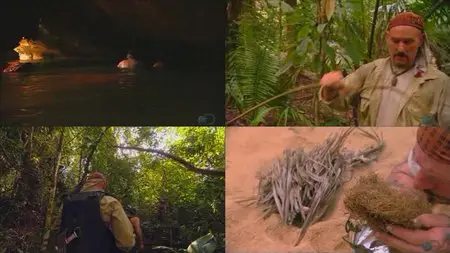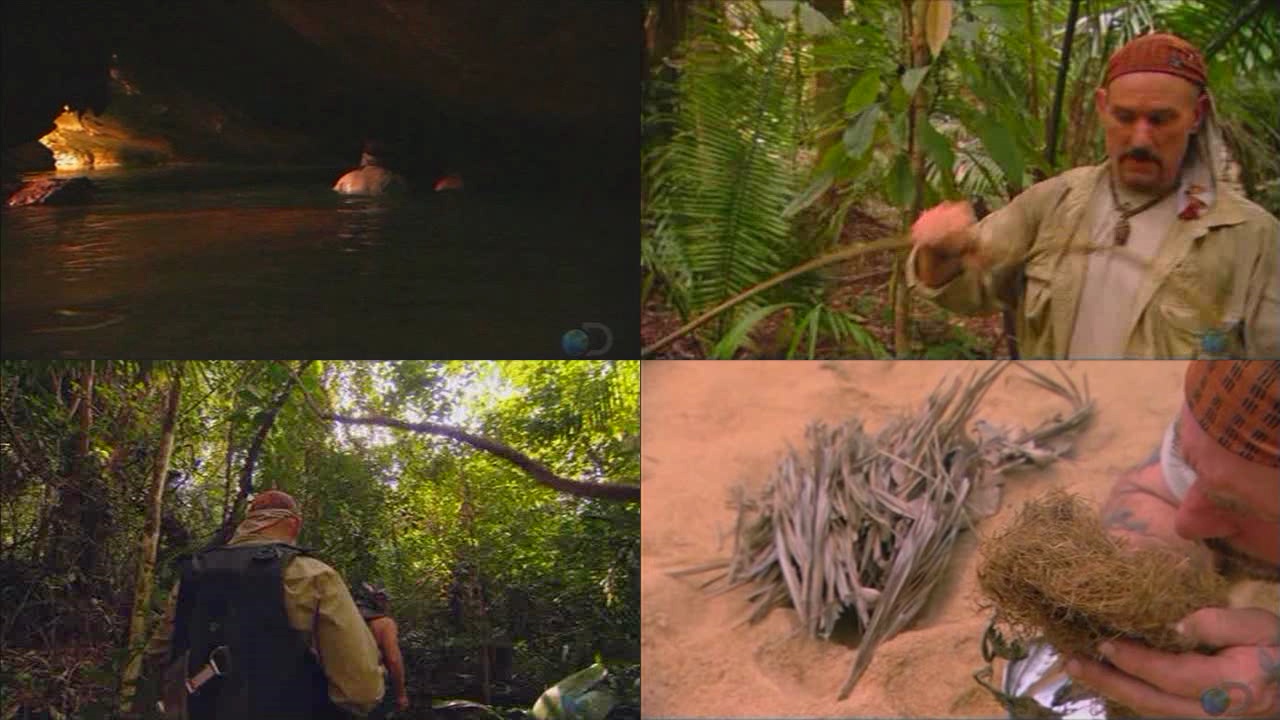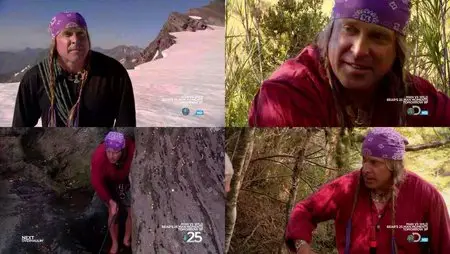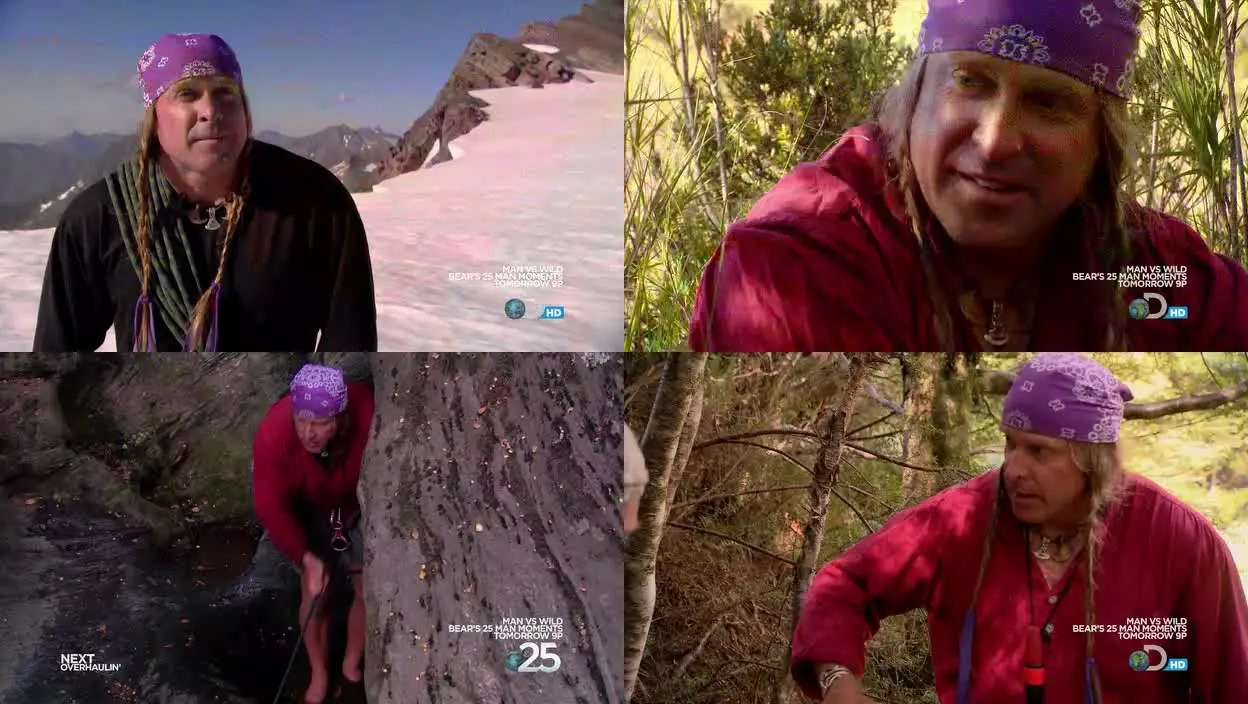Discovery: Dual Survival Season 1 (2010)
HDTV-Rip, TVRip | AVI | English | 430 min | 624x352 | XviD - 979 Kbps | MP3 - 126 Kbps | 3,4 GB
Genre: Documentary, Adventure, Reality-TV
IMDB rating: 7.4/10 (146 votes)
Starring: Dave Canterbury and Cody Lundin
HDTV-Rip, TVRip | AVI | English | 430 min | 624x352 | XviD - 979 Kbps | MP3 - 126 Kbps | 3,4 GB
Genre: Documentary, Adventure, Reality-TV
IMDB rating: 7.4/10 (146 votes)
Starring: Dave Canterbury and Cody Lundin
Experts agree there are some very basic - and universal - rules for surviving in the wild. Find shelter, find water, find food, find help. Beyond that, there's not much they agree on. Meet military-trained Dave Canterbury and naturalist Cody Lundin - trained survival experts featured in this series. Together, Canterbury and Lundin take on some of the planet's most unforgiving terrain to demonstrate - in their own way - how the right skills and some creative thinking can keep you alive.
Dave Canterbury joined the U.S. Army at age 17, eventually becoming a Special Reaction Team (SRT) instructor and sniper. He trained soldiers in the U.S., Central America and Korea in unarmed combat and close-quarter techniques. After leaving the Army, Canterbury worked on a reptile farm and as a commercial fisherman and diver in the Florida saltwater marshes. He put his background, skills and training to work for the next phase of his career - learning and now teaching wilderness survival.
Cody Lundin, who was trained as a survivalist by Native Americans, teaches minimalist self-reliant skills to students from his home deep in the Arizona desert. He spent two years living in a brush shelter in the woods where he slept on pine needles and cooked over an open fire. Today, Lundin lives off the grid in a self-designed solar earth home in the wilderness of northern Arizona where he catches rain, composts waste and pays nothing for heating and cooling. And he has been going barefoot for more than 20 years, part of his indigenous survival strategy. Together, with their drastically different backgrounds, the survivalists are dropped into a scenario that could happen to anyone: marooned boaters, lost hikers, stranded mountain climbers. Equipped with minimal gear that would have been carried in the real-life situations, Canterbury and Lundin must draw upon their arsenal of skills to devise extraordinary ways to use what they can find in their surroundings, as well as ordinary objects, and demonstrate what it takes to stay alive. How will they use a 35mm camera, condoms and a pack of cigarettes in the Laos jungle? Or a car battery, electrical wiring, tires and seat cushions from a broken-down car in Peru?
Description Episodes:
In this survival scenario, hosts Cody Lundin and Dave Canterbury find themselves on a deserted island off the coast of Nova Scotia - in the dead of winter with plummeting temperatures. Despite the freezing temperatures - and his partner's objections - Cody doesn't give in on his indigenous survival strategy, where he lives his life barefoot. Here, he's only wearing shorts and wool socks. The only items they have are those they're able to salvage from the life raft they used to reach the island: an emergency mylar blanket, a plastic tarp, two knives and a single rescue flare. They must use these items and their arsenal of skills to find shelter, build a fire and find food and water - showing what it takes to survive.
Dave Canterbury and Cody Lundin join forces once again, this time taking on a lost hiker scenario in the sweltering jungles of Laos. The items given to them for their journey include typical (or not so typical!) items a backpacker might carry: a 35 mm camera, condoms and a pack of cigarettes. They bushwhack their way through dense terrain, following a stream - considered the most surefire way to reach civilization. Along their trek, the survival experts find themselves at odds over the best way to hydrate themselves. Canterbury drinks from a creek he believes to be safe from parasites. Unwilling to take that risk, Lundin relies on hydration from the stalk of wild banana palm. The two eventually come to a wide river they believe is the way to help. But to travel the river, they must first join forces to lash together a homemade raft with bamboo and Lao vines.
Dave Canterbury and Cody Lundin take on a mountaineer's worst nightmare. They are stranded on top of a mountain in New Zealand with limited supplies that would be carried by a climber: rope, crampons, an ice axe and other climbing gear. They battle 8,000-foot glacial peaks, unstable crevasses and deep rocky canyons as they trek down the mountain on a course set by Canterbury, an experienced climber. To find food, Lundin uses his knowledge of local cultures, borrowing from the dietary rituals of the Maori - New Zealand's indigenous people. He rummages for huhu, the larvae of a local beetle, and hand-fishes for giant eel. Together, they show what it takes to survive.
Each year, an average of 20 people drown while cave diving. For this survival scenario, survival experts Cody Lundin and Dave Canterbury are lost SCUBA divers who are fortunate to find air, but they are deep inside the maze of caves in Belize. Equipped with only their dive gear - mask, fins, wetsuit, buoyancy compensator and flashlights - they must find their way out and to safety. The survival rules that work above ground, like following a river downstream, don't apply in the labyrinth of underground caves. Instead, they must make their way upstream. The slippery rocks along the way put Cody's barefoot philosophy to the ultimate test. Once they emerge, the situation goes from bad to worse - they find themselves surrounded by dense jungle, a web of vines and thorn ravaged terrain …and snakes. Once again, their differing philosophies come into play. Dave sees a pair of mating snakes as a meal but Cody believes it's "bad juju" to disturb them. They must find a way to work together to show what it takes to survive.
Survival experts Cody Lundin and Dave Canterbury head into Peru's infamous 'Valley of the Volcanoes' to take on the ultimate lost-in-the-desert survival scenario - a broken down car, miles from civilization, in the middle of a lava-scorched land with few vital survival resources. Here, Dave and Cody take on two roles to show how to survive this desolate location: Dave stays with the vehicle and signals for rescue while Cody heads out in search of water. But first, Dave and Cody strip the car for everything it's worth, salvaging the battery, headlights, electrical wiring, tires and seat cushions. They fight volcanic rock, heat exhaustion, altitude sickness, dehydration, rodents and a debilitating illness that literally brings Cody to his knees.
Survival experts Dave Canterbury and Cody Lundin take on a nightmarish scenario: stranded, miles apart, in Arizona. Their mission: trek through the tough terrain to find each other and then together make their way to civilization. Dave begins his journey at 8,000 feet above sea level in the Ponderosa Pine forest, where trees block his view at every turn. With no compass and barely a view of the sun, Dave must find his way back to his partner - but not before night and its freezing temperatures hit. And without a fire-starting device, it's a recipe for hypothermia. Further south, Cody prepares for Dave's arrival in a totally different ecosystem: the high desert scrub country. But, an Arizona native, he's on his own turf. In this inhospitable terrain, Cody readies for long-term survival, using his extensive desert survival knowledge to find water, build fire, and construct a variety of signals to help Dave find him. Once they reunite, the pair tackles some of the most challenging terrain Arizona has to offer as they make their way out to civilization…and to safety.
Survival experts Cody Lundin and Dave Canterbury are in the heart of the Louisiana bayou to take on a potentially deadly scenario: lost in a 1,000 square mile labyrinth of water channels and bogs with an estimated 1.5 million alligators and six species of poisonous snakes including water moccasins. To make it out, Dave and Cody are equipped only with what a lost boater might have, including a knife, flashlight, backpack, cords and the most valuable asset of all - the boat itself. In a swamp filled with predators, the vessel will create a vital barrier during the escape. But without enough gasoline to run the motor, Dave and Cody must improvise. Weather is another factor in the Louisiana swamps. Dave and Cody must not only deal with heat but also torrential rain. Even in warm weather, getting wet in a survival situation is life-threatening. Just four hours in 80 degree water can lower core body temperature and kick off hypothermia. The two experts must endure the elements, find food and water and make their way to safety to show what it takes to survive the swamps of Louisiana.
For two boat-wrecked hunters, surviving the 600,000 acre Pacific Northwest rainforest takes keen navigation skills and the know-how to stay warm, procure calories and signal for rescue. Survival experts Dave Canterbury and Cody Lundin are teaming up to take on this life-or-death scenario and show what it takes to survive. Dave and Cody are equipped with minimal gear: a ferrocerium rod or "metal match" for starting fire, a garbage bag and a three-piece longbow-but no arrows. The ultimate goal is to head west to the coast for self-rescue, but the immediate objective is making the oncoming night survivable. Both Dave and Cody are soaked through from rain, and the temperatures could drop to the 40s. Water conducts heat away from the body 25 times faster than air, making hypothermia a very real threat, and fire and shelter the priority.
Cody's minimalist survival style takes him on a gathering recon for food, but munching on a few tree-bark grubs won't cut it. But he does stumble on an old piece of trash: a broken glass bottle. Glass is a survival specialist's dream find; it's a cutting tool and can also be whittled down into a weapon, something Dave needs to go after big game. Dave creates a makeshift arrow from Cody's glass and heads out in search of big game hunt, and tracks down a prize catch: a wild turkey. The path to the coast, and safety, is rife with obstacles-the first of which is a deep gorge, with only one way across: a treacherous fallen tree trunk. The guys weigh the options - sliding down a slippery tree 40 feet above a gorge or hiking for miles alongside it - and decide to take a risk. Slowly but surely, Dave and Cody crawl safely across the canyon, and continue west, where they finally reach a coast. They see a boat on the horizon, but from miles away, the two men are invisible on the beach. They need to somehow signal for help and attract it before another frigid night rolls in.
In a hurricane's aftermath, Cody and Dave find survival resources in an unlikely place-trash. But their journey to the Dominican Republic's coast is filled with creatures that sting, and Dave ignores Cody's advice about hunting the deadliest of them all.
More than a thousand miles inland from the Atlantic Coast of Brazil lies the Pantanal - at over 50,000 square miles it's the largest wetland in the world, and bigger than the state of New York. It's also full of dangerous predators like piranha, anaconda, and South American crocodile called caiman. Cody and Dave take on the roles of lost wildlife enthusiasts in this vast, uncharted waterway. To find civilization, they'll use what might be found in an explorer's backpack: a machete, an empty water bottle, a magnesium bar for starting fires, a sewing kit, and the backpack itself. Their journey begins wading through waist-deep water without any land in sight. Their first goal is obvious: get to dry land. It's not only the best way to find civilization, but these waters are full of predators and Cody's still not wearing shoes. Even a small cut could spell the end. Piranha troll these waters and can smell blood from over a mile away. But without a sliver of land in sight, Dave and Cody decide to construct a raised shelter to get out of the water, just as the native Guato people did for centuries.
Download links:
Episode 1. Shipwrecked (350 MB)
http://www.filesonic.com/fi...val.S01E01.Shipwrecked.avi
http://hotfile.com/dl/97419...01E01.Shipwrecked.avi.html
Episode 2. Panic in the Jungle (350 MB)
http://www.filesonic.com/fi...05.Panic.in.the.Jungle.avi
http://hotfile.com/dl/97428...nic.in.the.Jungle.avi.html
Episode 3. Failed Ascent (350 MB)
http://www.filesonic.com/fi...l.S01E02.Failed.Ascent.avi
http://hotfile.com/dl/97421...E02.Failed.Ascent.avi.html
Episode 4. Out of Air (350 MB)
http://www.filesonic.com/fi...ival.S01E03.Out.of.Air.avi
http://hotfile.com/dl/97424...S01E03.Out.of.Air.avi.html
Episode 5. Desert Breakdown (350 MB)
http://www.filesonic.com/fi...01E04.Desert.Breakdown.avi
http://hotfile.com/dl/97426....Desert.Breakdown.avi.html
Episode 6. Split Up (350 MB)
http://www.filesonic.com/fi...rvival.S01E07.Split.Up.avi
http://hotfile.com/dl/97432...l.S01E07.Split.Up.avi.html
Episode 7. Swamped (350 MB)
http://www.filesonic.com/fi...urvival.S01E06.Swamped.avi
http://hotfile.com/dl/97430...al.S01E06.Swamped.avi.html
Episode 8. Soaked (350 MB)
http://www.filesonic.com/fi...Survival.S01E08.Soaked.avi
http://hotfile.com/dl/97435...val.S01E08.Soaked.avi.html
Episode 9. After the Storm (350 MB)
http://www.filesonic.com/fi...S01E09.After.the.Storm.avi
http://hotfile.com/dl/97437...9.After.the.Storm.avi.html
Episode 10. Bogged Down (350 MB)
http://www.filesonic.com/fi...val.S01E10.Bogged.Down.avi
http://hotfile.com/dl/97440...01E10.Bogged.Down.avi.html
No Mirrors, Please
Episode 1. Shipwrecked (350 MB)
http://www.filesonic.com/fi...val.S01E01.Shipwrecked.avi
http://hotfile.com/dl/97419...01E01.Shipwrecked.avi.html
Episode 2. Panic in the Jungle (350 MB)
http://www.filesonic.com/fi...05.Panic.in.the.Jungle.avi
http://hotfile.com/dl/97428...nic.in.the.Jungle.avi.html
Episode 3. Failed Ascent (350 MB)
http://www.filesonic.com/fi...l.S01E02.Failed.Ascent.avi
http://hotfile.com/dl/97421...E02.Failed.Ascent.avi.html
Episode 4. Out of Air (350 MB)
http://www.filesonic.com/fi...ival.S01E03.Out.of.Air.avi
http://hotfile.com/dl/97424...S01E03.Out.of.Air.avi.html
Episode 5. Desert Breakdown (350 MB)
http://www.filesonic.com/fi...01E04.Desert.Breakdown.avi
http://hotfile.com/dl/97426....Desert.Breakdown.avi.html
Episode 6. Split Up (350 MB)
http://www.filesonic.com/fi...rvival.S01E07.Split.Up.avi
http://hotfile.com/dl/97432...l.S01E07.Split.Up.avi.html
Episode 7. Swamped (350 MB)
http://www.filesonic.com/fi...urvival.S01E06.Swamped.avi
http://hotfile.com/dl/97430...al.S01E06.Swamped.avi.html
Episode 8. Soaked (350 MB)
http://www.filesonic.com/fi...Survival.S01E08.Soaked.avi
http://hotfile.com/dl/97435...val.S01E08.Soaked.avi.html
Episode 9. After the Storm (350 MB)
http://www.filesonic.com/fi...S01E09.After.the.Storm.avi
http://hotfile.com/dl/97437...9.After.the.Storm.avi.html
Episode 10. Bogged Down (350 MB)
http://www.filesonic.com/fi...val.S01E10.Bogged.Down.avi
http://hotfile.com/dl/97440...01E10.Bogged.Down.avi.html
No Mirrors, Please


